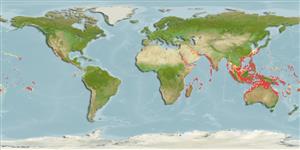Common names from other countries
Environment: milieu / climate zone / depth range / distribution range
Ecologia
marinhas associadas(os) a recifes; intervalo de profundidade 2 - 80 m (Ref. 90102). Tropical; 32°N - 32°S
Indo-West Pacific: India and Sri Lanka eastward to Tonga; south to Australia; north to Japan.
Tamanho / Peso / Idade
Maturity: Lm ? range ? - ? cm
Max length : 17.0 cm TL macho/indeterminado; (Ref. 9710)
Espinhos dorsais (total) : 13; Raios dorsais moles (total) : 9 - 10; Espinhos anais: 3; Raios anais moles: 5 - 6. Body reddish with vague broad bars; paired fins with bars; median fins with small dark spots (Ref. 4313). Mid-dorsal spines shorter than body depth (Ref. 37816).
Common in reef flats and shallow lagoons, in areas with weed-covered rocks on sandy substrates. Adults often found on sponges and juveniles are sometimes found in small aggregations on remote bommies with 10 or so individuals (Ref. 48635). Nocturnal. Feeds on small crustaceans (Ref. 37816).
Life cycle and mating behavior
Maturities | Reprodução | Spawnings | Egg(s) | Fecundities | Larvas
Distinct pairing (Ref. 205). Females possess specialized ovarian structures including stalk-like ovigerous lamellae and secretory epithelia (Ref. 32832).
Eschmeyer, W.N., 1986. Scorpaenidae. p. 463-478. In M.M. Smith and P.C. Heemstra (eds.) Smiths' sea fishes. Springer-Verlag, Berlin. (Ref. 4313)
Categoria na Lista Vermelha da IUCN (Ref. 130435)
CITES (Ref. 128078)
Not Evaluated
Utilização humana
Pescarias: pescarias de subsistência; Aquário: Espécies comerciais
Ferramentas
Relatórios especiais
Descarregue XML
Fontes da internet
Estimates based on models
Preferred temperature (Ref.
115969): 24.4 - 29, mean 27.8 (based on 1188 cells).
Phylogenetic diversity index (Ref.
82804): PD
50 = 0.5078 [Uniqueness, from 0.5 = low to 2.0 = high].
Bayesian length-weight: a=0.01230 (0.00700 - 0.02163), b=3.11 (2.96 - 3.26), in cm Total Length, based on LWR estimates for this species & (Sub)family-body (Ref.
93245).
Nível Trófico (Ref.
69278): 3.6 ±0.4 se; based on diet studies.
Resiliência (Ref.
120179): Médio, tempo mínimo de duplicação da população 1,4 - 4,4 anos (Preliminary K or Fecundity.).
Fishing Vulnerability (Ref.
59153): Low vulnerability (10 of 100).
